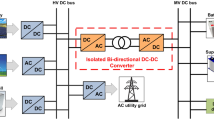Abstract
Integration and coordinated operation of renewable energy sources (RESs) offer to conventional consumers the possibility to control energy production and consumption in order to obtain technical and economic benefits. In this work, a mixed-integer linear programming approach is proposed to model and optimize DC-coupled grid-tied microgrids. The objective is to reduce industrial consumer electricity bill and energy storage systems degradation, considering operational constraints and rules defined by a complex binomial differentiated tariff and net metering policies to exchange energy. A novel model is developed to DC-coupling integration considering the efficiency of power transformation process and elements with two possible power flow conditions. An original formulation based on logical constraints is also proposed to model the net metering policies and to find the best compensation energy strategy for solving the optimization problem. A case study of a Brazilian industrial consumer, owner of a real-world DC grid-tied microgrid, is presented. The proposed approach involves low-cost procedures that can be integrated into a commercial solution to optimize microgrids in similar net metering contexts, encouraging the use of RESs in developing countries.





Similar content being viewed by others
References
ANEEL. (2015). Normative Resolution 687 (in portuguese). http://www2.aneel.gov.br/cedoc/ren2015687.pdf. Accessed 1 June 2018.
ANNEL. (2010). Normative Resolution 414 (in portuguese). http://www2.aneel.gov.br/cedoc/ren2010414.pdf. Accessed 14 May 2015.
Bordin, C., Anuta, H. O., Crossland, A., Gutierrez, I. L., Dent, C. J., & Vigo, D. (2017). A linear programming approach for battery degradation analysis and optimization in offgrid power systems with solar energy integration. Renewable Energy, 101, 417–430.
Bordons, C., García-Torres, F., & Valverde, L. (2015). Optimal energy management for renewable energy microgrids. Revista Iberoamericana de Automática e Informatica Industrial, 12, 117–132.
Dufo-López, R., Bernal-Agustín, J. L., & Contreras, J. (2007). Optimization of control strategies for stand-alone renewable energy systems with hydrogen storage. Renewable Energy, 32, 1102–1126.
Fonseca, A. G., Langner, A. L., López-Salamanca, H., Siebert, L. C., Ferronato, F. A. S., Aoki, A. R., Alves, P., Riella R., et al. (2015). Building integrated photovoltaics for smart grids. In Proceedings of 2015 IEEE PES innovative smart grid technologies Latin America, Montevideo, Uruguay. https://doi.org/10.1109/ISGT-LA.2015.7381267.
Gambino, G., Verrilli, F., Meola, D., Himanka, M., Del Vecchio, C., & Glielmo, L. (2014). Model predictive control for optimization of combined heat and electric power microgrid. In Proceedings of the 19th IFAC World Congress, Cape Town, South Africa. https://doi.org/10.3182/20140824-6-ZA-1003.02354.
Garcia-Torres, F., Valverde, L., & Bordons, C. (2016). Optimal load sharing of hydrogen-based microgrids with hybrid storage using model-predictive control. IEEE Transactions on Industrial Electronics, 63, 4919–4928.
GUSEK. (2014). GLPK Under Scite Extended Kit. http://gusek.sourceforge.net/gusek.html. Accessed 2 November 2014.
HOMER Energy. (2015). Global standard in microgrid software. http://www.homerenergy.com/index.html. Accessed 13 July 2015.
Januzzi, G., & Augustos, C. (2013). Grid-connected photovoltaic in Brazil: Policies and potential impacts for 2030. Energy for Sustainable Development, 17, 40–46.
López-Salamanca, H., Arruda, L., Magatão, L., & Normey-Rico, J. (2014). Using a MILP model for battery bank operation in the white tariff Brazilian context. In Proceedings of the international renewable energy congress, Hammammet, Tunisia. https://doi.org/10.1109/IREC.2014.6826921.
Lotfi, H., & Khodaei, A. (2017). AC versus DC microgrid planning. IEEE Transactions on Smart Grid, 8(1), 296–304.
Nehrir, M. H., Wang, C., Strunz, K., Aki, H., Ramakumar, R., Bing, J., et al. (2011). A review of hybrid renewable/alternative energy systems for electric power generation: Configurations, control, and applications. IEEE Transactions on Sustainable Energy, 2, 392–403.
Nejabatkhah, F., & Li, Y. W. (2015). Overview of power management strategies of hybrid AC/DC microgrid. IEEE Transactions on Power Electronics, 30, 7072–7089.
Palizban, O., Kauhaniemi, K., & Guerrero, J. M. (2014). Microgrids in active network management—Part I: Hierarchical control, energy storage, virtual power plants, and market participation. Renewable and Sustainable Energy Reviews, 36, 428–439.
Parisio, A., Rikos, E., & Glielmo, L. (2016). Stochastic model predictive control for economic/environmental operation management of microgrids: An experimental case study. Journal of Process Control, 43, 24–37.
Peukert, W. (1897). Über die Abhängigkeit der Kapazität von der Entladestromstärke bei Bleiakkumulatoren. Elektrotechnische Zeitschrift, 18, 287–288.
Ratnam, E. L., Weller, S. R., & Kellet, C. M. (2015). Scheduling residential battery storage with solar PV: Assessing the benefits of net metering. Applied Energy, 155, 881–891.
Ravichandrad, A., Sirouspour, S., Malysz, P., & Emadi, A. (2018). A chance-constraints-based control strategy for microgrids with energy storage and integrated electric vehicles. IEEE Transactions on Smart Grid, 9, 346–359.
Sherali, H. D. (2001). On mixed-integer zero-one representations for separable lower-semicontinuous piecewise-linear functions. Operations Research Letters, 28, 155–160.
Yao, J., & Venkitasubramaniam, P. (2015). Optimal end user energy storage sharing in demand response. In Proceedings of the 2015 IEEE international conference on smart grid communications, Miami, USA. https://doi.org/10.1109/SmartGridComm.2015.7436296
Acknowledgements
Technical support from the Institute of Technology for Development—LACTEC is gratefully acknowledged. The authors also acknowledge CNPq, Grants 305816/2014-4, 401126/2014-5, 305785/2015-0 and 406507/2016-3 and CAPES, PDSE program, process 88881.135220/2016-01.
Author information
Authors and Affiliations
Corresponding author
Rights and permissions
About this article
Cite this article
López-Salamanca, H.L., Arruda, L.V.R., Magatão, L. et al. Optimization of Grid-Tied Microgrids Under Binomial Differentiated Tariff and Net Metering Policies: A Brazilian Case Study. J Control Autom Electr Syst 29, 731–741 (2018). https://doi.org/10.1007/s40313-018-0403-x
Received:
Revised:
Accepted:
Published:
Issue Date:
DOI: https://doi.org/10.1007/s40313-018-0403-x




